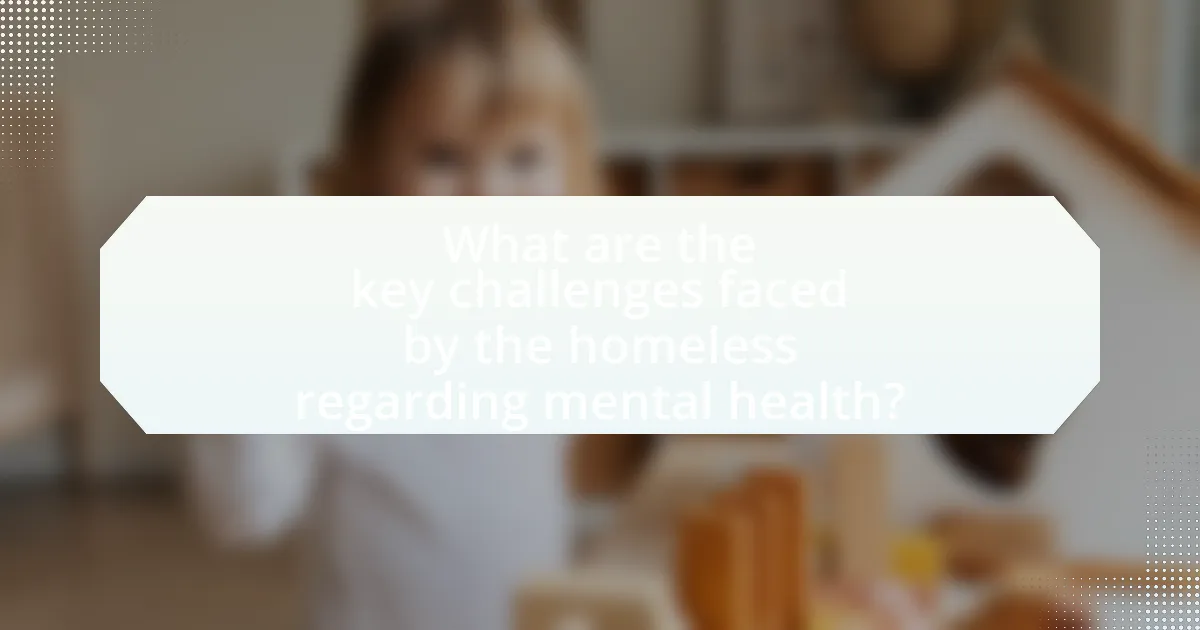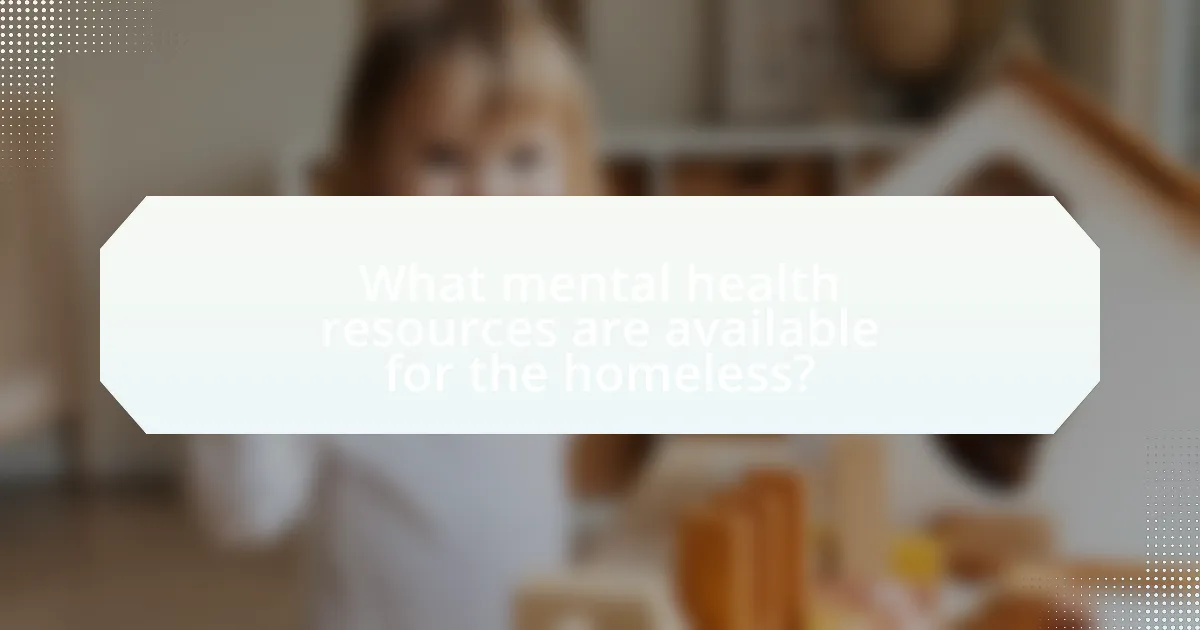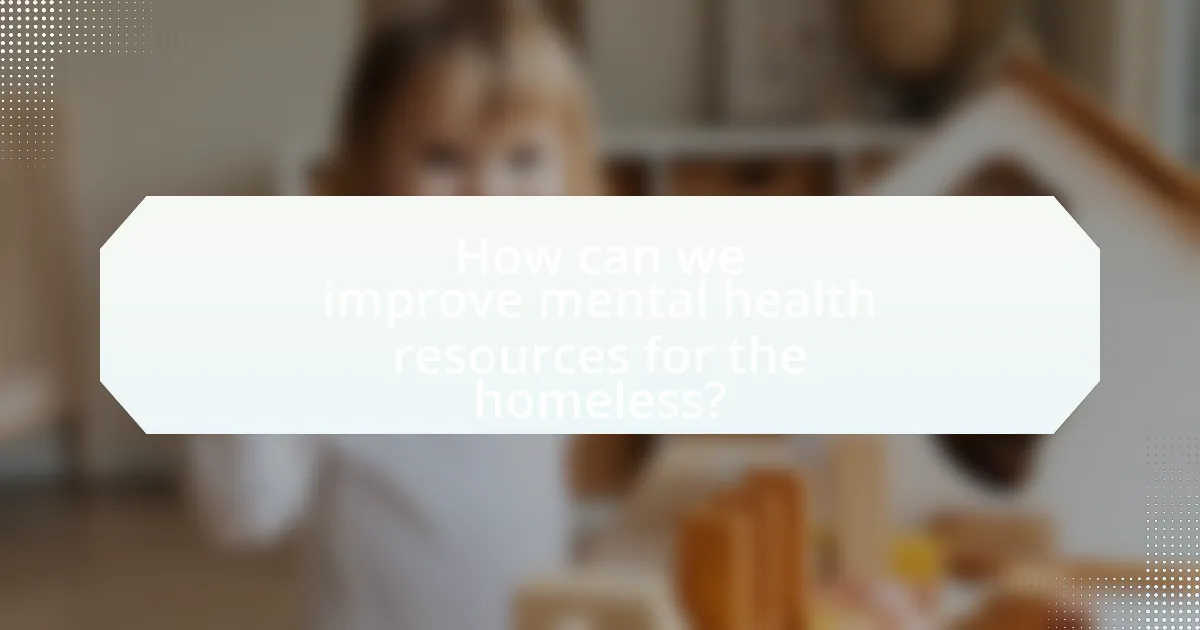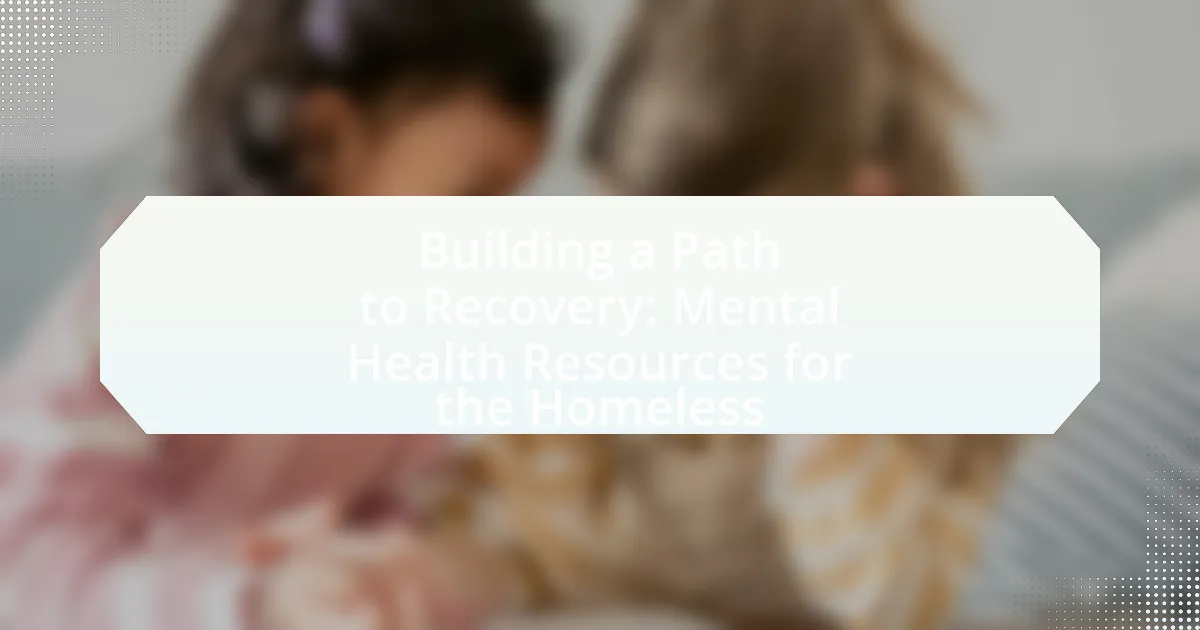The article “Building a Path to Recovery: Mental Health Resources for the Homeless” addresses the critical mental health challenges faced by homeless individuals, including limited access to healthcare, stigma, and co-occurring disorders. It highlights the significant impact of homelessness on mental health, with a focus on prevalent issues such as depression, anxiety, PTSD, and schizophrenia. The article explores barriers to accessing mental health resources, including logistical challenges and societal stigma, while also detailing available support systems like outreach programs, crisis intervention services, and supportive housing. Additionally, it discusses innovative approaches and best practices for improving mental health support, emphasizing the importance of integrated services and community involvement in fostering recovery for this vulnerable population.

What are the key challenges faced by the homeless regarding mental health?
The key challenges faced by the homeless regarding mental health include lack of access to healthcare, stigma, and co-occurring disorders. Homeless individuals often struggle to obtain mental health services due to financial constraints, limited availability of resources, and transportation issues. Stigma surrounding mental illness can lead to social isolation and reluctance to seek help. Additionally, many homeless individuals experience co-occurring disorders, such as substance abuse alongside mental health issues, complicating their treatment and recovery. According to the National Coalition for the Homeless, approximately 20-25% of the homeless population suffers from severe mental illness, highlighting the urgent need for targeted mental health resources and support systems.
How does homelessness impact mental health?
Homelessness significantly impacts mental health by increasing the risk of mental disorders and exacerbating existing conditions. Individuals experiencing homelessness often face chronic stressors such as lack of stable housing, social isolation, and exposure to violence, which can lead to anxiety, depression, and post-traumatic stress disorder (PTSD). Research indicates that approximately 30% of homeless individuals suffer from serious mental illness, compared to about 5% in the general population. Additionally, the National Coalition for the Homeless reports that homelessness can lead to a cycle of worsening mental health, as unstable living conditions hinder access to treatment and support services.
What specific mental health issues are prevalent among the homeless population?
The specific mental health issues prevalent among the homeless population include depression, anxiety disorders, post-traumatic stress disorder (PTSD), and schizophrenia. Research indicates that approximately 30% of homeless individuals experience serious mental illness, with depression and anxiety being the most common. A study published in the American Journal of Psychiatry found that PTSD affects around 25% of homeless individuals, often due to traumatic experiences related to their homelessness. Additionally, the prevalence of schizophrenia in this population is significantly higher than in the general population, with estimates ranging from 10% to 20%. These mental health challenges are compounded by factors such as substance abuse and lack of access to healthcare, further complicating the recovery process.
How do environmental factors contribute to mental health struggles for the homeless?
Environmental factors significantly contribute to mental health struggles for the homeless by exposing them to adverse living conditions, social isolation, and lack of access to resources. These individuals often face extreme weather conditions, which can exacerbate physical health issues and lead to increased psychological stress. For instance, studies indicate that homelessness is associated with higher rates of anxiety, depression, and post-traumatic stress disorder, largely due to the instability and unpredictability of their environment. Additionally, the absence of safe and secure housing limits their ability to access mental health services, further compounding their struggles. Research from the National Alliance to End Homelessness highlights that environmental stressors, such as noise, pollution, and overcrowding, can negatively impact mental well-being, making recovery more challenging for this vulnerable population.
What barriers do homeless individuals face in accessing mental health resources?
Homeless individuals face significant barriers in accessing mental health resources, primarily due to lack of stable housing, financial constraints, and stigma. The absence of stable housing often leads to difficulties in maintaining consistent treatment, as many mental health services require a permanent address for registration and follow-up. Financial constraints further exacerbate this issue, as many homeless individuals lack health insurance or the means to pay for services, limiting their access to necessary care. Additionally, stigma surrounding mental health issues can deter individuals from seeking help, as they may fear judgment or discrimination from service providers or society at large. Research indicates that these barriers contribute to the underutilization of mental health services among homeless populations, highlighting the need for targeted interventions to improve access and support.
How does stigma affect the willingness to seek help?
Stigma significantly reduces the willingness to seek help among individuals facing mental health challenges. Research indicates that negative perceptions associated with mental illness lead to feelings of shame and fear of judgment, which discourage individuals from accessing necessary support services. For instance, a study published in the journal “Psychological Medicine” found that individuals who perceive high levels of stigma are 2.5 times less likely to seek professional help compared to those who do not perceive stigma. This reluctance to seek help can exacerbate mental health issues and hinder recovery, particularly among homeless populations who may already face multiple barriers to accessing care.
What logistical challenges hinder access to mental health services?
Logistical challenges that hinder access to mental health services include transportation barriers, limited availability of services, and inadequate funding. Transportation barriers prevent individuals from reaching mental health facilities, particularly in rural or underserved urban areas where public transport options are scarce. Limited availability of services arises from a shortage of mental health professionals, which can lead to long wait times for appointments. Inadequate funding for mental health programs restricts the resources necessary to expand services and improve accessibility, as evidenced by the National Alliance on Mental Illness reporting that nearly 60% of adults with mental illness did not receive mental health services in the previous year due to these logistical issues.

What mental health resources are available for the homeless?
Mental health resources available for the homeless include crisis intervention services, mental health clinics, and supportive housing programs. Crisis intervention services, such as mobile crisis teams, provide immediate assistance to individuals experiencing mental health emergencies. Mental health clinics offer counseling, medication management, and therapy specifically tailored for homeless individuals, often at no cost. Supportive housing programs combine housing assistance with mental health services, helping individuals maintain stable living conditions while receiving ongoing support. According to the Substance Abuse and Mental Health Services Administration, these integrated approaches significantly improve mental health outcomes for homeless populations.
What types of mental health services are specifically designed for the homeless?
Mental health services specifically designed for the homeless include outreach programs, crisis intervention services, case management, and supportive housing with integrated mental health care. Outreach programs actively engage homeless individuals in their environments, providing immediate access to mental health assessments and services. Crisis intervention services offer immediate support during mental health emergencies, often through mobile crisis teams. Case management connects homeless individuals with ongoing mental health treatment, social services, and housing resources, facilitating a comprehensive approach to recovery. Supportive housing integrates mental health care with stable living conditions, significantly improving outcomes for homeless individuals with mental health issues. These services are essential as studies indicate that homeless individuals experience higher rates of mental illness, with estimates suggesting that up to 30% of the homeless population suffers from severe mental disorders.
How do outreach programs operate to connect with homeless individuals?
Outreach programs operate by deploying trained professionals to engage directly with homeless individuals in their environments, such as streets, shelters, and encampments. These programs utilize a combination of relationship-building, resource distribution, and service referrals to establish trust and facilitate access to essential services, including mental health support. For instance, the National Alliance to End Homelessness reports that effective outreach often includes providing immediate necessities like food and hygiene products, which can serve as entry points for deeper conversations about health and housing needs. By fostering connections through consistent and compassionate interactions, outreach programs can effectively link homeless individuals to long-term support systems and resources.
What role do shelters play in providing mental health support?
Shelters play a crucial role in providing mental health support by offering a safe environment where individuals experiencing homelessness can access essential services. These facilities often provide mental health resources such as counseling, therapy, and support groups, which are vital for addressing the psychological challenges faced by this population. Research indicates that shelters can significantly reduce symptoms of anxiety and depression among residents, as they create a structured environment that fosters stability and social connections. For instance, a study published in the American Journal of Public Health found that individuals who utilized shelter services reported improved mental health outcomes compared to those who did not. This evidence underscores the importance of shelters in facilitating mental health recovery for homeless individuals.
How can community organizations assist in mental health recovery for the homeless?
Community organizations can assist in mental health recovery for the homeless by providing access to mental health services, support groups, and housing assistance. These organizations often offer counseling, therapy, and medication management, which are essential for addressing mental health issues. For example, the National Alliance on Mental Illness reports that individuals experiencing homelessness are at a higher risk for mental health disorders, and community organizations can bridge the gap by connecting them with necessary resources. Additionally, programs that focus on stable housing have been shown to improve mental health outcomes, as evidenced by studies indicating that stable housing reduces symptoms of mental illness and increases overall well-being.
What partnerships exist between mental health services and local shelters?
Partnerships between mental health services and local shelters often include collaborative programs that provide integrated care for individuals experiencing homelessness. These partnerships typically involve mental health professionals offering on-site counseling, crisis intervention, and psychiatric services within the shelter environment. For example, the National Alliance to End Homelessness highlights initiatives where shelters work with local mental health agencies to create supportive housing programs that address both housing stability and mental health needs. Such collaborations aim to reduce barriers to accessing mental health care, ensuring that vulnerable populations receive comprehensive support tailored to their circumstances.
How do peer support programs benefit homeless individuals with mental health issues?
Peer support programs benefit homeless individuals with mental health issues by providing emotional support, practical assistance, and a sense of community. These programs connect individuals with peers who have experienced similar challenges, fostering trust and understanding. Research indicates that peer support can lead to improved mental health outcomes, increased engagement in treatment, and reduced feelings of isolation. A study published in the “American Journal of Psychiatry” found that participants in peer support programs reported higher levels of hope and lower levels of depression compared to those who did not participate. This evidence underscores the effectiveness of peer support in enhancing the well-being of homeless individuals facing mental health challenges.

How can we improve mental health resources for the homeless?
To improve mental health resources for the homeless, we can implement integrated service models that combine mental health care with housing support. Research indicates that programs like the Housing First model, which prioritizes providing stable housing before addressing mental health issues, have shown significant success in reducing homelessness and improving mental health outcomes. A study by the National Alliance to End Homelessness found that individuals in Housing First programs experienced a 60% reduction in psychiatric symptoms and a 70% reduction in substance use. Additionally, increasing funding for mental health services specifically targeted at homeless populations can enhance access to care, as evidenced by the Substance Abuse and Mental Health Services Administration’s report highlighting the need for tailored interventions.
What innovative approaches are being implemented to enhance mental health support?
Innovative approaches to enhance mental health support include the integration of technology, such as teletherapy and mobile mental health applications, which provide accessible and immediate assistance to individuals in need. Research indicates that teletherapy can reduce barriers to access, with a study published in the Journal of Medical Internet Research showing that 75% of participants reported improved mental health outcomes after using teletherapy services. Additionally, community-based programs that incorporate peer support and wraparound services have been effective; for instance, the Pathways to Housing initiative has demonstrated success in providing comprehensive support to homeless individuals, resulting in a 70% reduction in psychiatric symptoms among participants. These approaches leverage both technology and community resources to create a more inclusive and effective mental health support system.
How can technology be leveraged to provide mental health resources to the homeless?
Technology can be leveraged to provide mental health resources to the homeless through mobile applications, telehealth services, and data analytics. Mobile applications can offer immediate access to mental health support, allowing users to connect with counselors and access resources discreetly. Telehealth services enable remote consultations, which can be particularly beneficial for individuals who may face barriers to in-person visits, such as transportation issues or stigma. Data analytics can identify trends and needs within homeless populations, allowing organizations to tailor their services effectively. For instance, a study by the National Alliance to End Homelessness found that integrating technology in outreach programs significantly improved engagement and access to mental health services for homeless individuals.
What role does public policy play in improving access to mental health services?
Public policy plays a crucial role in improving access to mental health services by establishing frameworks that allocate funding, set standards for care, and promote integration of services. For instance, policies such as the Mental Health Parity and Addiction Equity Act mandate that mental health services be covered by insurance at the same level as physical health services, thereby reducing financial barriers for individuals seeking care. Additionally, public policies can facilitate the development of community-based programs that specifically target underserved populations, including the homeless, ensuring that mental health resources are accessible where they are most needed. Research indicates that states with comprehensive mental health policies report higher rates of service utilization among vulnerable populations, demonstrating the effectiveness of such policies in enhancing access to necessary mental health care.
What best practices can be adopted to ensure effective mental health support for the homeless?
To ensure effective mental health support for the homeless, integrated service models that combine mental health care with housing assistance are essential. Research indicates that programs like the Housing First model, which prioritizes providing stable housing without preconditions, significantly improve mental health outcomes. For instance, a study published in the American Journal of Psychiatry found that participants in Housing First programs experienced reduced psychiatric symptoms and improved quality of life. Additionally, training staff in trauma-informed care enhances the ability to address the unique psychological needs of homeless individuals, fostering a supportive environment that encourages engagement with mental health services.
How can training for service providers improve mental health outcomes?
Training for service providers can significantly improve mental health outcomes by equipping them with the necessary skills and knowledge to effectively support individuals in need. Enhanced training programs focus on evidence-based practices, trauma-informed care, and cultural competency, which enable providers to better understand and address the unique challenges faced by homeless individuals experiencing mental health issues. Research indicates that trained providers are more likely to implement effective interventions, leading to increased engagement in treatment and improved overall mental health. For instance, a study published in the Journal of Mental Health found that training in motivational interviewing techniques resulted in a 30% increase in client adherence to treatment plans among homeless populations. This demonstrates that targeted training directly correlates with better mental health outcomes for vulnerable groups.
What strategies can be employed to reduce stigma around mental health in homeless communities?
To reduce stigma around mental health in homeless communities, strategies such as community education, peer support programs, and collaboration with local organizations can be employed. Community education initiatives can raise awareness about mental health issues and promote understanding, thereby reducing misconceptions. Peer support programs, where individuals with lived experiences of mental health challenges provide support to others, can foster a sense of belonging and acceptance. Collaboration with local organizations, including healthcare providers and social services, can create a more integrated approach to mental health care, ensuring that homeless individuals receive the necessary support without facing stigma. Research indicates that these strategies can effectively improve attitudes towards mental health and enhance access to care for marginalized populations.
What practical steps can individuals take to support homeless individuals with mental health issues?
Individuals can support homeless individuals with mental health issues by providing direct assistance, advocating for resources, and fostering community connections. Direct assistance includes offering food, clothing, or hygiene products, which can address immediate needs and build trust. Advocating for mental health resources involves connecting individuals to local shelters, counseling services, or healthcare providers, which can facilitate access to professional help. Fostering community connections can be achieved by engaging with local organizations that specialize in mental health and homelessness, thereby creating a supportive network that enhances recovery opportunities. Research indicates that community support significantly improves mental health outcomes for homeless individuals, highlighting the importance of these practical steps.

Leave a Reply